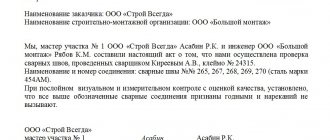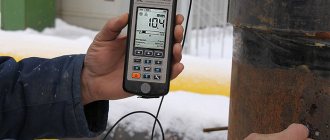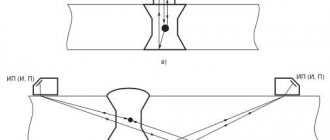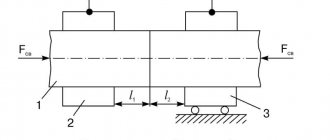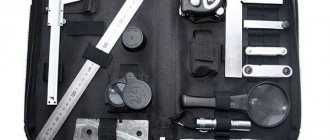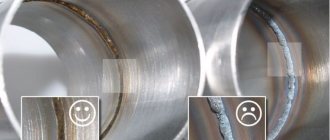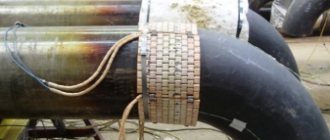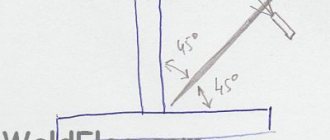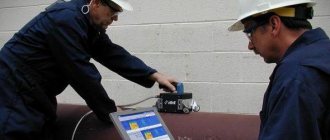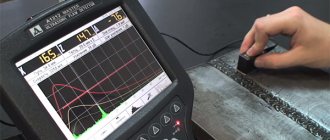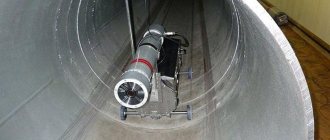Why is weld inspection necessary?
Welding joints are widely used in construction and in the manufacture of durable metal structures, so the slightest deviation from technical standards that occurs during their creation can carry significant risks. If the welds fail to cope with the load and the structure breaks, there will be not only inevitable financial losses, but also casualties both during the construction phase and when the structure is put into operation.
Often, welded joints are checked during the operation of the structure. This need is due to the fact that the seams, depending on operating conditions, may be subject to corrosion and other adverse effects.
Timely inspections are especially required when layers are fused onto old, worn pipes or structures. In this situation, each applied layer is inspected and checked, the thickness of the metal and the length of the connecting seam are measured, and all the data obtained is compared with the established standard for a given area, taking into account its load.
Regular checks and high-quality visual inspections help to detect seam damage in time, eliminate defects as soon as possible, as well as understand the cause of the destruction, and find ways to eliminate and further prevent damage.
Explanation for the design of the welding log
Title page 2
On this sheet it is written:
- Name of the organization engaged in welding work.
- The name of the object, as well as the name of the construction.
- Position, surname, initials and signature of the foreman, foreman responsible for welding and registration of the log.
- An organization or design institute that has developed a project/working documentation for welded metal structures.
- Project/working documentation (number, code).
- The organization that developed the project/detailed documentation for welded metal structures, as well as the work project code. As a rule, welding work is part of the general PPR for the entire facility.
- Organization, position, full name. and the signature of the technical supervision (construction control) of the customer.
- Dates of welding work.
List of engineers responsible for welding work
Columns 1-6
- FULL NAME. master or producer of work.
- The construction specialty or education of the foreman/work producer is indicated.
- Job title.
- The actual start date of welding work at the site (not the start date of journal keeping).
- Information about certification in welding production and the date of certification.
- Completion date of welding work at the site.
List of welders
Art. 1. Full name welder
Art. 2. Level of professional qualification of a welder.
Art. 3. Number of the assigned welder's mark .
The welder's mark is assigned by order of the organization in which he works and remains with him until the end of construction of the facility
Art. 4, 5, 6. Information about training for welding work is indicated, namely the number of the certificate (NAKS or others), its validity period and tolerance for spatial positions.
Art. 7. An assessment of the permissible welded joints is written, as well as the number of the permissible joint report.
Filling out the welding log
Columns No. 1-No. 13
- The date and change of welding of the joint is indicated.
- The parameters of the elements/parts to be welded are written down, as well as the steel grade of each element.
- The marking of the welded element/parts according to the project (working documentation) is indicated. In the case of welding work on several sections of the design documentation, the project code and sheet number are additionally indicated.
- The surname, initials and signature of the person responsible for the delivery for welding and acceptance of the welded unit are put down. As a rule, this person is a foreman or foreman responsible for welding and registration of the log.
- The brand of welding materials is indicated, as well as the batch number.
- Environmental conditions when welding a joint - air temperature when welding a joint. If welding work is performed outdoors, precipitation and wind speed are indicated.
- FULL NAME. welder, as well as the license number (indicated in the list of welders).
- Number of the assigned welder's mark.
- Signature of the welder listed in the column
- FULL NAME. a foreman or work producer responsible for welding work at a given facility/site (Indicated in the list of engineers involved in welding work).
- Signature of the person responsible for the welding work of the welder indicated in column 10.
- The result of inspection of the welded joint is written. The type of inspection of welded joints is indicated in the design or working documentation.
- Column for comments from supervisors.
By whom and how a visual inspection is carried out, and a report is drawn up
After the work is completed, an initial check of the quality of the seam is carried out by the welding specialist who made the connection. After the initial inspection, control is carried out by other technical specialists: for example, a site foreman, an engineer, etc.
It is very important that the inspection specialists have the necessary knowledge of visual inspection techniques for welded joints. Workers must have the necessary tools and equipment at their disposal. In addition, they must know how to correctly draw up a visual inspection report of welded joints, and draw it up in accordance with the regulations.
Thus, visual inspection is carried out in accordance with the following algorithm:
- Visual control . Preliminary check of the connection for corrosion and possible defects with simple measurements: width, thickness of the seam, etc.
- Quality control of welded joints . Quality control is carried out in order to obtain accurate parameters of external defects (after concluding a preliminary inspection report); the size of damage to welds is measured as a percentage deviation from the acceptable standard.
- Detailed (instrumental) examination of seams and recording of results . At this stage, deep defects are checked and ultrasonic testing of welded joints is used.
Specialists who carry out visual inspection of welded joints use several types of devices and tools.
How to check welds
In fact, a variety of methods can be used to examine welds, for example, ultrasonic, magnetic, chemical, capillary and other high-tech methods. However, the classic one, which is still relevant and in demand today, is a simple visual inspection. Its purpose: to make sure that the seam is of high quality, well welded, and has no undercuts, sagging, burns, excessive scaliness or other flaws. The advantages of this type of research are quite obvious: it does not require large expenses, it is accessible and quite informative, but along with this there are also disadvantages: the subjectivity of the examination, low reliability, the ability to examine only the visible part of the seam.
Visual inspection can be carried out both with the naked eye (usually, if we are talking about large, clearly visible seams), and with the help of various devices, such as lenses, microscopes, endoscopes, flaw detectors, etc.
They are used to identify the smallest hidden defects that are difficult to detect by simply examining the outside of the weld (for example, microscopic cracks, nicks, delamination, fractures, etc.). At the same time, there are devices that are intended only for use in laboratories and those that can be used “in the field.” The latter are able to withstand any temperature and weather conditions (including those that have an increased coefficient of radiation, chemical, bacteriological, etc. danger to humans).
Necessary devices
To carry out monitoring under various operating conditions, the following instruments are required:
- Instruments for workshop purposes . Such instruments can operate at temperatures from +5 °C to +20 °C at normal atmospheric pressure and moderate humidity.
- Field use devices . Such devices can operate in a temperature range from -55 °C to +60 °C and can withstand moderate shaking and precipitation.
When carrying out measurement control, the following tools are used:
- measuring magnifiers;
- calibration squares;
- protractors;
- calipers and depth gauges;
- probes;
- pipe wall meters and thickness gauges;
- micrometers;
- calibers;
- tape measures, rulers;
- special templates , etc.
How to correctly draw up a visual inspection report for welds
Currently, the visual inspection report is drawn up in any form. It is drawn up on the basis of a template that is developed and approved by the organization carrying out the work.
Registration procedure
The act can be drawn up by hand or printed on a printer; to draw up the act, you can use a form with the organization’s corporate logo and its details; it is also possible to use a simple sheet of paper.
The act must be certified by the signatures of the responsible persons, and it is drawn up in only one original copy and receives a unique number.
All data about the act is registered and a special accounting journal is entered, in which a mark is placed on the document number and the date of its creation. The act must be stored in accordance with the regulations and rules of the organization; it is stored in a separate folder in the company archive.
Information that must be included in the act
Despite the fact that the law does not regulate the precise form of drawing up the act, there are some information that must be recorded in it without fail:
- At the beginning of the document, the name of the organization and the date of creation of the act are written down.
- The positions and details of the specialists who inspected the welded joint are recorded.
- In the main part of the act, information about the performer of the work is entered : position of specialist, full name. Also, the main part of the document contains information about the examined welds: their numbers, steel grade, etc.
- All tools and instruments that were used during inspection and control are listed , all methods used, the results of the inspection and work performed are prescribed, and brief recommendations are given on the methods of control and inspection.
- The results of the inspection and control carried out are summed up , and the signatures of the responsible parties are affixed.
Sample of the act
Welding certificate for control joint
To assess the quality of welded joints, the concept of a control welded joint has been established. A control welded joint is considered to be identical to the controlled production welded joints: the steel grades of the joined elements, their thickness and diameter, the type and design of the joint, and the shape of the edges must be the same. When testing joints of the same type, the thickness and diameter of the control welded joint must correspond to one of the standard sizes of welded joints. The technological process for making a control welded joint must correspond to the technological process used in the manufacture of controlled fittings or when connecting them to a pipeline. The same welding method must be used, in the same position, the same welding materials, the same brand and the same diameter, under the same conditions, with the same heating, with the same heat treatment, etc. Control welded joints must be made in the same period of time as the production welded joints they control, by the same welder, on the same equipment and using the same technology, under the supervision of specially designated responsible persons.
Heat treatment of control connections must be carried out together with the product (during general heat treatment in an oven), and if this is not possible, separately using heating and cooling methods and temperature conditions established by the PTD for production connections. If controlled welded joints are subjected to repeated heat treatment, then the control joint must undergo the same number of heat treatments under the same conditions. If the production connection has been subjected to multiple high temperings, then the control connection can be subjected to a single tempering with a holding time of at least 80% of the total holding time for all high temperings of the production connection.
The control welded joint must be 100% controlled using the same non-destructive testing methods that are provided for production welded joints. If the control results are unsatisfactory, the control connections must be made again in double quantity. If unsatisfactory results are obtained during repeated non-destructive testing, then the overall result is considered unsatisfactory. In this case, the quality of materials, equipment and qualifications of the welder must be subjected to additional checks.
All welded joints must have a mark or other symbol that allows the name of the welder who made the connection to be identified.
All data relating to the technological process of performing the control welded joint must be entered into the control joint welding report, which is signed by the welder and other responsible persons.
